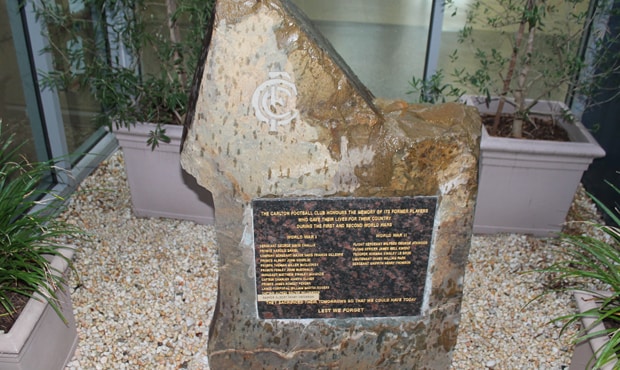This time last year, on the 100th anniversary of the Gallipoli landings, a permanent memorial to Carlton’s Great Fallen of two world wars was unveiled at the old ground.
That solemn morning, in a ceremony involving the coaches, players and staff, the stone memorial and plaque carrying the names of 16 former Carlton footballers lost in conflict was unveiled by Joan Schinner. Joan was just a little girl when her father the 1938 Carlton Premiership player Jim Park was killed in action in Wau, New Guinea on February 9, 1943.
Assisting Joan in the unveiling was Chad Nash, the great nephew of 10-game former Carlton footballer Fenley McDonald who was killed at Gallipoli on April 25, 1915.
“Fen” was one of 11 Carlton footballers known to have lost their lives in the war to end all wars, until January this year when a twelfth – Carlton’s “lost soldier” Albert (“Alby”) Henry Paterson – surfaced some 96 years after his untimely passing.
The breakthrough came by way of an email forwarded to the football club by David Paterson, to whom Alby was a great uncle.
Now domiciled in Tura Beach, a suburb of Merimbula on New South Wales’ South Coast, David wrote to ask whether Alby could be recognised as a former Carlton footballer who made the ultimate sacrifice in wartime.
Alby’s service record, it seems, was not known to this club’s or the AFL’s historians, as his surname was incorrectly recorded as Patterson with two ts rather than one.
Read the profiles of Carlton's Great Fallen
David advised that Alby was born in the old goldmining town of Happy Valley, just south of Ballarat near the town of Smythesdale in 1875. Happy Valley no longer exists.
Recruited from nearby Ascot Vale, Alby represented Carlton in the then VFA years through the winters of 1892-’96, and turned out for his one and only League appearance for the old dark Navy Blues in the second round of 1897.
That came against South Melbourne at the Lakeside Oval, when Paterson A. took his place in the pivot.
On parting company with Carlton, Alby, together with his wife Sarah Gazzard and daughter Amy, relocated to the Western Australian goldfields town of Kalgoorlie. There, from 1900 until 1915, Alby and Sarah parented three more children - Laura, Kenneth and Jessie - and Alby chased the leather for the Mines Rovers Football Club.

Carlton's Great Fallen memorial plaque at Ikon Park. (Photo: Carlton Media)
“Alby was selected to play for WA in the state carnival of 1904, but his son died and he was unable to play,” David said.
Alby was 41 when he answered the nation’s call, enlisting for wartime duties on December 31, 1916. Service records show that he stood five feet seven inches in the old measurement and tipped the scales at 180 pounds. His was a fair complexion, with hazel eyes and brown hair, and he carried a scar on the left side of his upper lip (no doubt obscured by the handlebar moustache). He also stated his occupation as miner.
In August 1917 in Melbourne, Alby hauled his kitbag up the gangway of the Southampton-bound ship Themistocles en route to France.
At the Australian General Base Depot in Rouelles some three months later, he joined members of the 3rd Australian Tunnelling Company, which was aligned with the Royal Australian Engineers for the course of the war. Each tunnelling unit was occupied in offensive and defensive mining which involved the placing and maintaining of mines under enemy lines, as well as other underground work such as the construction of deep dugouts for troop accommodation, the digging of subways, saps (a narrow trench dug to approach enemy trenches), cable trenches and underground chambers for signals and medical services.
During the Allies’ great advance to victory in Autumn of 1918, the 3rd Australian Tunnelling Company was responsible for the construction of a road bridge at Moudit under shellfire. What exactly happened to Alby is unclear, but what is known is that by July of 1918 he was admitted to hospital with lobar pneumonia –a form of pneumonia that affects a large and continuous area of the lobe of a lung.
Alby was still in hospital when the Armistice was declared and four days later, on November 15, 1918, was transferred to the 3rd Aust Auxiliary Hospital at Dartford. Not until late December did he board a hospital ship bound for home.
The H.T. Marmara departed the Liverpool docks on December 21, 1918 with Sapper Paterson invalided home for discharge due to pneumonia. Urine test was conducted during the voyage and Sarah was advised by Base Records of her husband’s impending return.
The Marmara finally docked in Fremantle on January 27, 1919. On March 2 of that year, Alby was discharged from the Military due to medical unfitness and awarded a pension.
Twelve months later, on April 16, 1920 Albert Henry Paterson died at Trafalgar, a goldfields town some three kilometres east of Boulder.
Last week, the club arranged for the etching of Sapper Albert Henry Paterson’s name into the plaque beneath the names of the 11 other Carlton footballers who so bravely gave their lives in the First World War.
Lest we forget.


